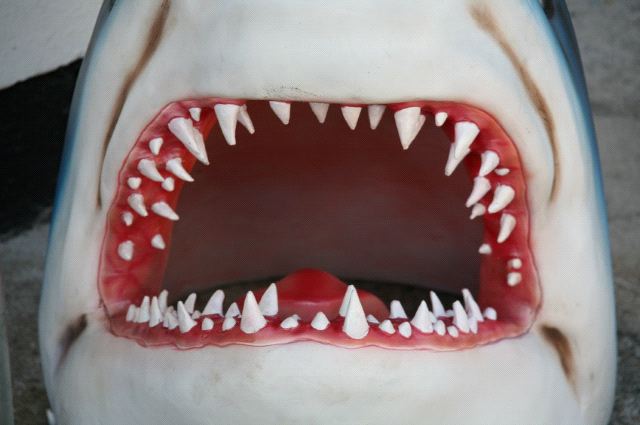Jawed fish
The evolution of the jaw was such a major biological innovation among vertebrates that groups without jaws, the agnathans, were virtually wiped out, no match for the superior jawed predators.
 (36 kb) Vertebrates with articulated jaws are called gnathostomes, from the Greek gnathos for jaw, and stoma for mouth. One hypothesis is that jaws developed from the first gill arches in as yet undiscovered or unidentified agnathan fish. This idea, although widely accepted, is not unanimous. Studies into the development of modern shark embryos provide supporting evidence. But no matter their origin, one thing remains certain: the development of the jaw meant the appearance of teeth!
(36 kb) Vertebrates with articulated jaws are called gnathostomes, from the Greek gnathos for jaw, and stoma for mouth. One hypothesis is that jaws developed from the first gill arches in as yet undiscovered or unidentified agnathan fish. This idea, although widely accepted, is not unanimous. Studies into the development of modern shark embryos provide supporting evidence. But no matter their origin, one thing remains certain: the development of the jaw meant the appearance of teeth!
Gnathostomes are classified into five large groups: the chondrichthyans (cartilaginous fish like the sharks, rays and chimaeras), placoderms (a group of platy fish, extinct at the beginning of the Carboniferous), acanthodians (small fish with spines, extinct during the Permian), actinopterygians (ray-finned fish), and sarcopterygians (lobe-finned fish).
Chondrichthyans are the only group not represented at Miguasha, probably because the distribution of sharks and their direct ancestors was, and still is, mainly restricted to the sea. The variable and often low salinity in an estuary is generally unsuitable for chondrichthyan survival.
But the four other groups are well represented in the paleoestuary. In fact, three species of placoderms, four acanthodians, one actinopterygian and at least nine sarcopterygians have all been discovered at Miguasha. Ancient gnathostomes thus began an evolutionary trend that led to a long reign of jawed animals, now accounting for the vast majority of present day vertebrates.

 (36 kb) Vertebrates with articulated jaws are called gnathostomes, from the Greek gnathos for jaw, and stoma for mouth. One hypothesis is that jaws developed from the first gill arches in as yet undiscovered or unidentified agnathan fish. This idea, although widely accepted, is not unanimous. Studies into the development of modern shark embryos provide supporting evidence. But no matter their origin, one thing remains certain: the development of the jaw meant the appearance of teeth!
(36 kb) Vertebrates with articulated jaws are called gnathostomes, from the Greek gnathos for jaw, and stoma for mouth. One hypothesis is that jaws developed from the first gill arches in as yet undiscovered or unidentified agnathan fish. This idea, although widely accepted, is not unanimous. Studies into the development of modern shark embryos provide supporting evidence. But no matter their origin, one thing remains certain: the development of the jaw meant the appearance of teeth!Gnathostomes are classified into five large groups: the chondrichthyans (cartilaginous fish like the sharks, rays and chimaeras), placoderms (a group of platy fish, extinct at the beginning of the Carboniferous), acanthodians (small fish with spines, extinct during the Permian), actinopterygians (ray-finned fish), and sarcopterygians (lobe-finned fish).
Chondrichthyans are the only group not represented at Miguasha, probably because the distribution of sharks and their direct ancestors was, and still is, mainly restricted to the sea. The variable and often low salinity in an estuary is generally unsuitable for chondrichthyan survival.
But the four other groups are well represented in the paleoestuary. In fact, three species of placoderms, four acanthodians, one actinopterygian and at least nine sarcopterygians have all been discovered at Miguasha. Ancient gnathostomes thus began an evolutionary trend that led to a long reign of jawed animals, now accounting for the vast majority of present day vertebrates.
Site map | Feedback | Links | Sources | Credits
Jawed fish
<< Levesquaspis | Placoderms >>



